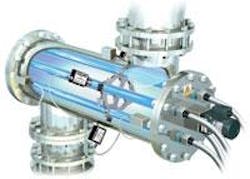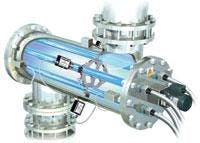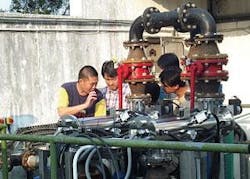Asian UV market offers tremendous potential
Clients in water-scarce countries in Asia are turning to wastewater reuse in order to develop alternative water sources for industry and irrigation. And closed-pipe, medium-pressure ultraviolet treatment systems are increasingly being used to disinfect the tertiary-treated effluent.
Ultraviolet (UV) disinfection technology is gaining increasing importance in the Asian countries of China, Korea, Singapore, and Taiwan as one treatment method that removes harmful pathogens from drinking water and wastewater, does not rely on the use of chemicals, and leaves no unwanted residues or by-products.
Tremendous opportunities for water and wastewater treatment and re-use equipment and processes are opening up in China. Under the Chinese government's 10th Five-Year Plan for the Development of the Environmental Protection Industry (2001-2005), 45% of all urban sewage must be treated by 2005, with the rate increasing to 60% in cities of over half a million people. Sixty percent of all industrial wastewater must also be recycled. The total output value of the environmental industry is expected to reach US$ 24 billion by 2005, with an annual growth rate of 15% per year. The World Bank is also financing a large number of projects involving wastewater treatment and management.
To achieve these ambitious targets, China must rely heavily on foreign investment and capital. The government, therefore, recently announced its decision to open its water and wastewater utility markets to foreign investors in order to accelerate the commercialization of the sector. Consequently, many European and American suppliers are establishing operations in China.
UV is already widely used in Europe and North America. Recent advances in UV technology are now also allowing it to be used to reduce pesticides and other contaminants from groundwater.
In Hong Kong, the Drainage Services Department recently installed two Hanovia Photon medium pressure (MP) UV systems in order to meet more stringent requirements on the Total Residue Chlorine of discharged effluent. The Hanovia systems treat secondary effluent from local residents and businesses from the Kwu Tung area in the New Territories.
UV systems also disinfect drinking water. Because UV kills all known water-borne pathogens, such as bacteria (including Cryptosporidium) and viruses, it offers a viable, low-maintenance alternative to chlorination. As MP UV kills microorganisms permanently, there is no danger of subsequent re-infection. If required, residual chlorine can be added to the water prior to distribution, but the amount required is very low.
In South Korea, another Hanovia medium-pressure UV system disinfects tertiary-treated effluent from the city of Yangsan. South Korea faces similar water pollution and scarcity problems to China. Surface water provides more than 90% of the country's water needs and, because the quantity of wastewater generated surpasses the capability of treatment facilities available, excessive dumping of untreated effluent directly into rivers has led to an alarming rise in pollution. The government has started to build more water and wastewater treatment facilities, and upgrade existing plants to reduce the pollution load on surface water.
The reuse of UV-treated effluent is increasingly important to the water-poor countries of China, Korea, Taiwan and Singapore. In Singapore, for example, closed-pipe MP UV systems from Hanovia are being used at the NEWater installation to disinfect tertiary treated industrial effluent, which is then re-used for industrial applications. Singapore is heavily dependant on Malaysia for its water supply, so this kind of installation offers a serious alternative to imported water.
Officials responsible for specifying disinfection systems must choose from a bewildering array of UV options; therefore they must first gain an understanding of industry trends and UV systems’ capabilities.
Closed-pipe, MP UV systems have many advantages over more traditional treatment technologies and should certainly be given serious consideration. Traditionally, UV wastewater treatment systems have been of the open-channel, low-pressure variety. With rapid advances in MP technology, however, this is now changing and closed-pipe, MP systems are now taking over. Closed-pipe systems are highly compact and take up very little space - an important consideration in densely populated areas. This technology can make a significant contribution to pollution reduction and water conservation in water-scarce countries.
Author's Note
David Marsden is the technical director of Hanovia Limited, based in Slough, England.


